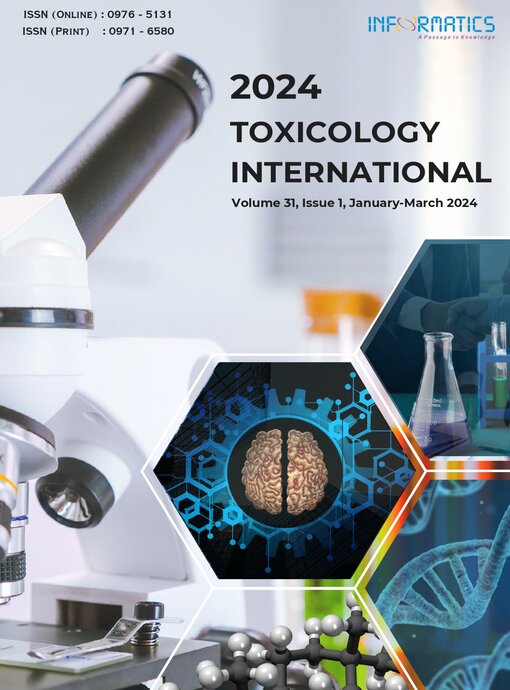Evaluation of Anti-Asthmatic and In Vitro Anti-Oxidant Potential of Tragia involucrata Linn
DOI:
https://doi.org/10.18311/ti/2024/v31i1/34774Keywords:
Asthma Inflammation, Arachidonic Acid, Tragia involucrataAbstract
The objective is to evaluate the in vivo anti-asthmatic and in vitro antioxidant potential of Hydroalcoholic Leaf Extract of Tragia involucrata (HAETI) on experimental animals. In vivo anti-asthmatic activity of HAETI was evaluated by Arachidonic acid-induced Leucocytosis and Eosinophilia in guinea pigs, Arachidonic acid-induced mast cell degranulation in guinea pigs, and Mast cell Degranulation studies. Parameters like hematological analysis, percentage protection against mast cell degranulation, and time of occurrence of Pre-Convulsion Dyspnea (PCD) were calculated as the end point of the study. Further sections of the lung were prepared for histopathology analysis. In addition, in vitro, anti-oxidant studies were carried out to determine the percentage of inhibition of HAETI on oxidative stress parameters. After the assigned treatment to the group of animals with HAETI showed normalized hematological parameters, the bronchodilatation effect was confirmed by a significant (p<0.001) increase in the latency time of Pre Convulsion Dyspnoea (PCD) and pre-treatment with HAETI in mast cell degranulation study showed significant (p<0.001) reduction in degranulation of mesenteric mast cell number. The histopathological analysis of lung sections showed a reduction of total histological score in HAETI-treated guinea pigs compared with the disease control group (p< 0.0001). Based on IC50 values from in vitro assays, the free radical scavenging property of HAETI was confirmed due to the presence of active phytoconstituents. Based on the above findings, it was concluded that Tragia involucrata could be effectively used in the treatment of asthma and justified with traditional claims of the plant.
Downloads
Published
How to Cite
Issue
Section
License
Copyright (c) 2024 M. Thenmozhi, Gokul Marimuthu, A. Krishnaveni, T. Venkata Rathina Kumar, K. Muthukrishnan

This work is licensed under a Creative Commons Attribution 4.0 International License.
Accepted 2023-11-07
Published 2024-02-28
References
Alagappan R, Manual of Practical Medicine, Third Edition Jaypee Brothers Medical Publisher. 2007; 218. https://doi.org/10.5005/jp/books/10483 DOI: https://doi.org/10.5005/jp/books/10483
Trease GE, Evans WC. Pharmacognosy. 15th ed. W.B. Sauders Company; 2002. p. 378.
Kulkarni SK. Handbook of Experimental Pharmacology, Vallabh Prakashan, Delhi; 2007. p. 168-71.
Nadakarni AK. The Indian Materia Medica, Popular Prakashan, Mumbai. 1976; 2:1175-80.
Miller DM, Buettner GR, Aust SD. Transition metals as catalysts of “autoxidation” reactions. Free Radic Biol Med. 1990; 8(1):95-108. https://doi.org/10.1016/0891- 5849(90)90148-C DOI: https://doi.org/10.1016/0891-5849(90)90148-C
Halliwell B. How to characterize an antioxidant: An update. Biochem Soc Symp. 1995; 61:73-101. https://doi. org/10.1042/bss0610073 DOI: https://doi.org/10.1042/bss0610073
Perumalsamy R, Gopalakrishnakone P, Sarumathi M, Ignacimuthu S. Wound healing potential of Tragia involucrate L. extract in rats. Fitoterapia. 2006; 77:300-2. https://doi.org/10.1016/j.fitote.2006.04.001 DOI: https://doi.org/10.1016/j.fitote.2006.04.001
Pallie MS, Perera PK, Goonasekara CL, Kumarasinghe KMN, Arawwawala LDAM. Evaluation of diuretic effect of the hot water extract of standardized Tragia involucrata Linn., in rats. Int J Pharmacol. 2017; 13(1):83-90. https:// doi.org/10.3923/ijp.2017.83.90 DOI: https://doi.org/10.3923/ijp.2017.83.90
Dhara AK, Suba V, Sen T, Pal S, Chaudhuri Nag AK. Preliminary studies on the anti- inflammatory and analgesic activity of the methanolic fraction of the root extract of Tragia involucrata Linn. J Ethnopharmacol. 2000; 72:265–8. https://doi.org/10.1016/S0378-8741(00)00166-5 DOI: https://doi.org/10.1016/S0378-8741(00)00166-5
Brekhman II, Dardymov IV. New substances of plant origin which increase nonspecific resistance. Annu Rev Pharmacol. 1969; 9:419-30. https://doi.org/10.1146/ annurev.pa.09.040169.002223 DOI: https://doi.org/10.1146/annurev.pa.09.040169.002223
Lakshmana M, Rafiq M, Sridhar BY. Evaluation of E-721B, an indigenous herbal combination in experimental models of immediate hypersensitivity. Indian J Physiol Pharmacol. 2001; 45(3):319-28. PMID: 11881571.
Chandrashekhar VM, Halagali KS, Nidavani RB, Shalavadi MH, Biradar BS, Biswas D, Muchchandi IS. Anti-allergic activity of German chamomile (Matricaria recutita L.) in mast cell-mediated allergy model. J Ethnopharmacol. 2011; 137(1):336-40. https://doi.org/10.1016/j.jep.2011.05.029 DOI: https://doi.org/10.1016/j.jep.2011.05.029
Christhudas IVN, Kumar PP, Sunil C, Vajravijayan S, Sundaram RL, Siril SJ, Agastian P. In vitro studies on α-glucosidase inhibition, antioxidant and free radical scavenging activities of Hedyotis biflora L. Food Chem. 2013; 138(2-3):1689-95. https://doi.org/10.1016/j. foodchem.2012.11.051 DOI: https://doi.org/10.1016/j.foodchem.2012.11.051
Philip Jacob P, Madhumitha G, Mary Saral A. Free radical scavenging and reducing power of Lawsonia inermis L. seeds. Asian Pac J Trop Med. 2011; 4(6):457-61. https://doi. org/10.1016/S1995-7645(11)60125-9 DOI: https://doi.org/10.1016/S1995-7645(11)60125-9
Hussen EM, Endalew SA. In vitro antioxidant and freeradical scavenging activities of polar leaf extracts of Vernonia amygdalina. BMC Complement Med Ther. 2023; 23(1):146. https://doi.org/10.1186/s12906-023-03923-y DOI: https://doi.org/10.1186/s12906-023-03923-y
Bandyopadhaya A, Kesarwani M, Que YA, He J, Padfield K, Tompkins R, Rahme LG. The quorum-sensing volatile molecule 2-amino acetophenone modulates host immune responses in a manner that promotes life with unwanted guests. PLoS Pathog. 2012; 8(11):e1003024. https://doi. org/10.1371/journal.ppat.1003024 DOI: https://doi.org/10.1371/journal.ppat.1003024
Passmore MR, Byrne L, Obonyo NG, et al. Inflammation and lung injury in an ovine model of fluid resuscitated endotoxemic shock. Respir Res. 2018; 19:231. https://doi. org/10.1186/s12931-018-0935-4 DOI: https://doi.org/10.1186/s12931-018-0935-4
Kovalszki A, Weller PF. Eosinophilia. Prim Care. 2016; 43(4):607-17. https://doi.org/10.1016/j.pop.2016.07.010 DOI: https://doi.org/10.1016/j.pop.2016.07.010
George L, Brightling CE. Eosinophilic airway inflammation: Role in asthma and chronic obstructive pulmonary disease. Ther Adv Chronic Dis. 2016; 7(1):34-51. https://doi. org/10.1177/2040622315609251 DOI: https://doi.org/10.1177/2040622315609251
Guill MF. Asthma update: Epidemiology and pathophysiology. Pediatr Rev. 2004; 25(9):299-305. https://doi.org/10.1542/ pir.25-9-299 DOI: https://doi.org/10.1542/pir.25-9-299
Bhatti MZ, Ali A, Ahmad A, Saeed A, Malik SA. Antioxidant and phytochemical analysis of Ranunculus arvensis L. extracts. BMC Res Notes. 2015; 8:279. https:// doi.org/10.1186/s13104-015-1228-3 DOI: https://doi.org/10.1186/s13104-015-1228-3
Qamar M, Akhtar S, Ismail T, Yuan Y, Ahmad N, Tawab A, Ismail A, Barnard RT, Cooper MA, Blaskovich MAT, Ziora ZM. Syzygium cumini (L.), Skeels fruit extracts: In vitro and in vivo anti-inflammatory properties. J Ethnopharmacol. 2021; 271:113805. https://doi.org/10.1016/j.jep.2021.113805 DOI: https://doi.org/10.1016/j.jep.2021.113805
 M. Thenmozhi
M. Thenmozhi







